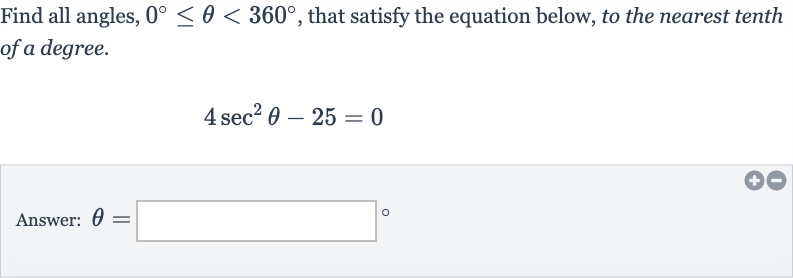Full solution
Q. Find all angles, , that satisfy the equation below, to the nearest tenth of a degree.Answer:
- Solve for : Solve the equation for .
Add to both sides.
Divide both sides by .
Take the square root of both sides. - Find cosine values: Find the corresponding cosine values since is the reciprocal of .
- Determine cosine quadrants: Determine the quadrants where cosine is positive and negative.Cosine is positive in the first and fourth quadrants and negative in the second and third quadrants.
- Principal angle for positive cosine: Use the inverse cosine function to find the principal angle for the positive cosine value. Calculate the principal angle.
- Second angle for positive cosine: Find the second angle in the first cycle ( to ) where cosine is positive.Since cosine is also positive in the fourth quadrant, the second angle is .
- Principal angle for negative cosine: Use the inverse cosine function to find the principal angle for the negative cosine value.Calculate the principal angle.
- Second angle for negative cosine: Find the second angle in the first cycle ( to ) where cosine is negative.Since cosine is also negative in the third quadrant, the second angle is .
More problems from Csc, sec, and cot of special angles
QuestionGet tutor help
QuestionGet tutor help
QuestionGet tutor help
QuestionGet tutor help
QuestionGet tutor help
QuestionGet tutor help
Question
. Find the value of in degrees.Write your answer in simplified, rationalized form. Do not round.____
Get tutor helpQuestionGet tutor help

